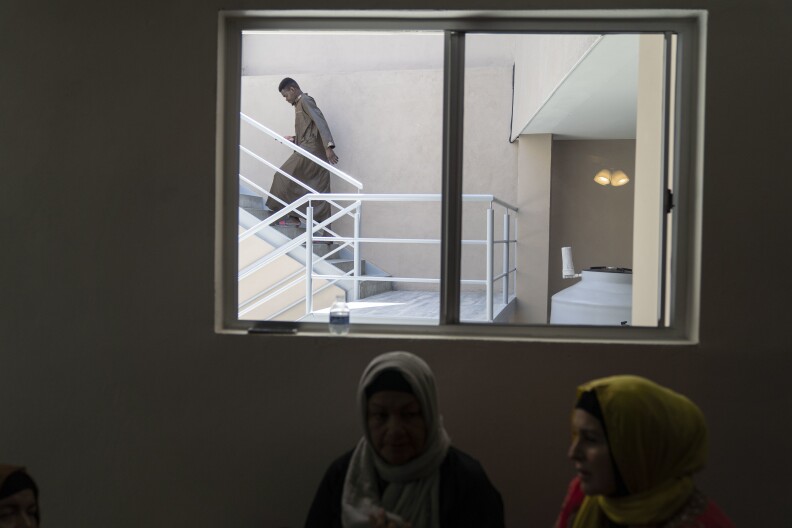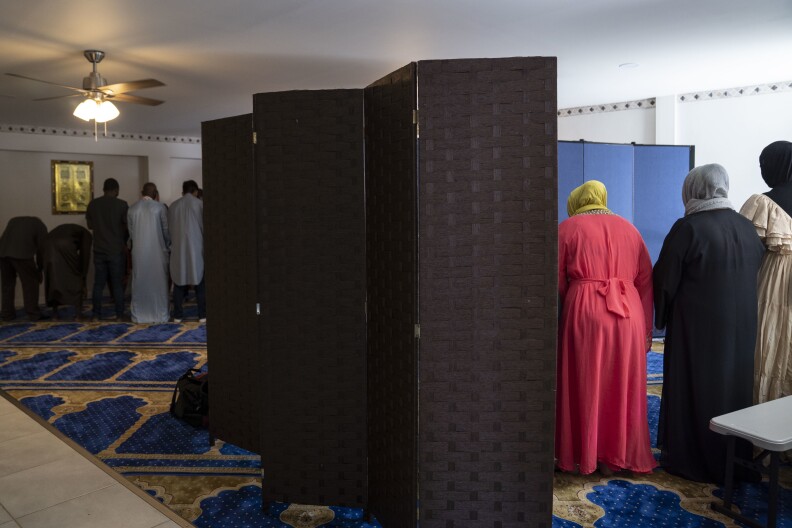With our free press under threat and federal funding for public media gone, your support matters more than ever. Help keep the LAist newsroom strong, become a monthly member or increase your support today.
'From haram to halal': How a bar became a shelter for Muslim migrants in Mexico

TIJUANA, Mexico — Six miles from the U.S.-Mexico border, Muslims gather to pray in an oud-scented musalla. The prayer room sits within a two-story, 8,000 square foot refugee shelter, complete with a minaret and a blue dome.
It's a beacon for Muslims arriving to the city from all over the world seeking a new life elsewhere.
"When they come here ... they feel comfortable," said Sonia García, president of the Latina Muslim Foundation, the organization that runs the shelter.
The shelter provides a number of services: legal assistance, medical care, language and Quran classes. There are separate quarters for men and women lined with bunk beds. There is also another room to quarantine people when they get sick.
The building was converted from an event space that was once used for quinceañeras and birthday parties. It has a commercial kitchen and a dining area. The musalla where local Muslims and shelter residents worship was once a bar.

"It used to be a drinking place ... We say from haram to halal," García jokes.
A few years ago, when García was volunteering at another migrant shelter, she noticed women in hijab. That got her thinking about creating a space where Muslims can feel more comfortable. One where they could pray five times a day and be served halal meals.
The women she saw that day were from Somalia. But since the shelter opened in June, García has welcomed people from Yemen, Afghanistan, and Russia.
García says there aren't a lot of Muslims in Mexico. She estimates there are around 100 in Tijuana and neighboring Rosarito. "It's enough to know that we're growing," she said. García herself converted to Islam from Catholicism.
Mexico is a Christian majority country. According to the 2020 Mexican government census, about 78% of the population identifies as Catholic and 11% as Protestant/Christian Evangelical. Only 0.2% identify with other religions, including Islam.


While Mexico is predominately Catholic, García says the local community has been receptive to the Muslim shelter. "They respect that we have certain rules – the way we pray, the way we eat, the way we live," she said.
Many of the people at the shelter left their home countries because of political persecution and war. "They don't want to leave," García said. "But if there is something dangerous ... they don't have a choice. They have to leave."
Some of those who arrive at the shelter are traumatized by what they experienced in their home countries. "Especially the kids," García said. "When they come here to Mexico, they're so scared they don't want to leave the room."
It can take months to build trust with children. She says some of them refuse to talk and others have anger issues. But she sympathizes with them.
"Imagine hearing bombs, guns every day," García said.
The shelter provides art classes and psychologists to try to help them cope. Refugees mostly learn about the shelter through word of mouth and social media.
García also talks with the directors of other shelters in Mexico to invite Muslims to come to hers. She tells them, "If you see someone praying on the floor, [who] does not eat pork, who has hijab ... send them to us."
For García, the hope is to make people feel safe and secure during some of the most daunting times of their life.
Copyright 2023 NPR. To see more, visit https://www.npr.org. 9(MDA1OTI3MjQ5MDEyODUwMTE2MzM1YzNmZA004))

At LAist, we believe in journalism without censorship and the right of a free press to speak truth to those in power. Our hard-hitting watchdog reporting on local government, climate, and the ongoing housing and homelessness crisis is trustworthy, independent and freely accessible to everyone thanks to the support of readers like you.
But the game has changed: Congress voted to eliminate funding for public media across the country. Here at LAist that means a loss of $1.7 million in our budget every year. We want to assure you that despite growing threats to free press and free speech, LAist will remain a voice you know and trust. Speaking frankly, the amount of reader support we receive will help determine how strong of a newsroom we are going forward to cover the important news in our community.
We’re asking you to stand up for independent reporting that will not be silenced. With more individuals like you supporting this public service, we can continue to provide essential coverage for Southern Californians that you can’t find anywhere else. Become a monthly member today to help sustain this mission.
Thank you for your generous support and belief in the value of independent news.

-
Tens of thousands of workers across Southern California walk out over pay and staffing issues.
-
People in and around recent burn scars should be alert to the risk of debris flows. Typical October weather will be back later this week.
-
Jet Propulsion Laboratory leadership says the cuts amount to 11% of the workforce.
-
The rock legend joins LAist for a lookback on his career — and the next chapter of his music.
-
Yes, it's controversial, but let me explain.
-
What do stairs have to do with California’s housing crisis? More than you might think, says this Culver City councilmember.







